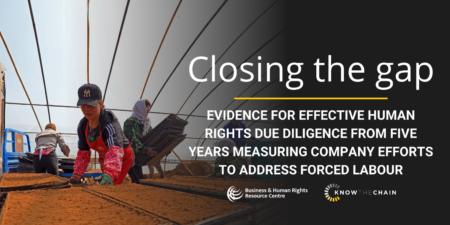KnowTheChain Views
Learn more about our work and how companies and investors are addressing forced labour.

FEATURED
Closing the gap: Evidence for effective human rights due diligence from five years measuring company efforts to address forced labour
This briefing utilises KnowTheChain data on 129 companies from nine benchmarks across three high-risk sectors: ICT, food and beverage, and apparel and footwear to influence the development of mandatory human rights and environmental due diligence legislation.
Benchmarks, News
2020 Information and Communications Technology Sector Benchmark
KnowTheChain released its third benchmark on the Information and Communications Technology (ICT) sector, assessing the efforts of the 49 largest global companies to address forced labor risks in their supply chains. With an average score of 30/100, and more than three-quarters of companies scoring less than 50/100, the sector is ill-prepared for the rising risks […]
Read More… from 2020 Information and Communications Technology Sector Benchmark
Read ArticleBenchmarks
2020 ICT Benchmark Overview
The 49 largest information communications and technology (ICT) companies have a combined market capitalization of US$5 trillion and combined annual profits of almost US$1 trillion. This brings with it a responsibility to prevent and address forced labor in supply chains, particularly when crises such as COVID-19 heighten risks for workers. Yet this third benchmark reveals […]
Read More… from 2020 ICT Benchmark Overview
Read ArticleNews
KnowTheChain names Felicitas Weber Project Director and 2020/21 Information and Communication Technology Benchmark launches June 9
KnowTheChain is a partnership between Humanity United, Business & Human Rights Resource Centre, Verité, and Sustainalytics. We are pleased to announce Felicitas Weber as the new Project Director of KnowTheChain. Felicitas Weber and her team at the Business & Human Rights Resource Centre have led the research, analysis and engagement for the KnowTheChain benchmark since […]
Read ArticleNews
COVID-19 demonstrates the need to address ESG risks in supply chains
This post originally appeared on Responsible Investor, read the original here. By Felicitas Weber and Sonal Mahida The widespread impact of the coronavirus pandemic is revealing a significant vulnerability in corporate supply chains — the potential for disruptions and delays born of employer-controlled working and living conditions that contribute to the spread of the virus. […]
Read More… from COVID-19 demonstrates the need to address ESG risks in supply chains
Read Article
Benchmarks, Blog, Investors, News
Investors representing $5 trillion sign KnowTheChain investor statement on forced labor – other investors should follow suit
At the start of 2020, KnowTheChain and the Investor Alliance for Human Rights are pleased to welcome the support of 135 investors representing a combined $5 trillion in assets under management. These investors recognize the urgent challenge of forced labor, how they may be exposed […]
Read ArticleNews
KnowTheChain Calls on Investors to Address Forced Labor Risks in the Forestry Sector
[…]
Read More… from KnowTheChain Calls on Investors to Address Forced Labor Risks in the Forestry Sector
Read ArticleBlog, Investors, News
KnowTheChain Calls on Investors to Address Forced Labor Risks in The Construction Sector
[…]
Read ArticleNews
Three Sectors, Three Years Later: Progress and Gaps in the Fight Against Forced Labor
After benchmarks in 2016 and 2018 KnowTheChain has collected data with which to compare corporate practice across industries, and over time. From this data KnowTheChain has identified areas where progress has been made but also where corporate practice continues to fall short on addressing forced labor: • Companies take little action to address exploitative recruitment […]
Read Article
News
What Can We Learn From Our Most Recent Benchmarks?
We launched the first KnowTheChain benchmarks in 2016 amid an increase in expectations for companies to report on risks of forced labor in their supply chains. Our intention was to move focus away from legal compliance and instead shift action toward assessing the implementation of effective practices. With the completion of our 2018 benchmarks there is now comparative data over two evaluation years that identifies where critical attention is needed. […]
Read More… from What Can We Learn From Our Most Recent Benchmarks?
Read Article



